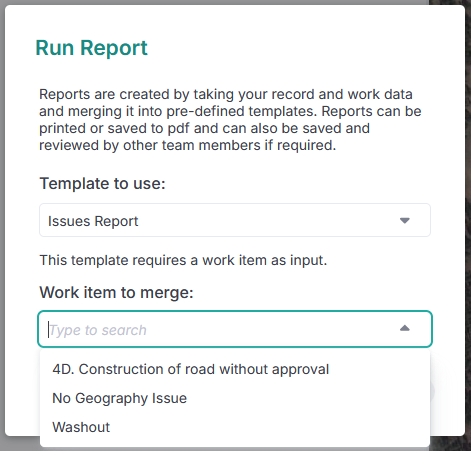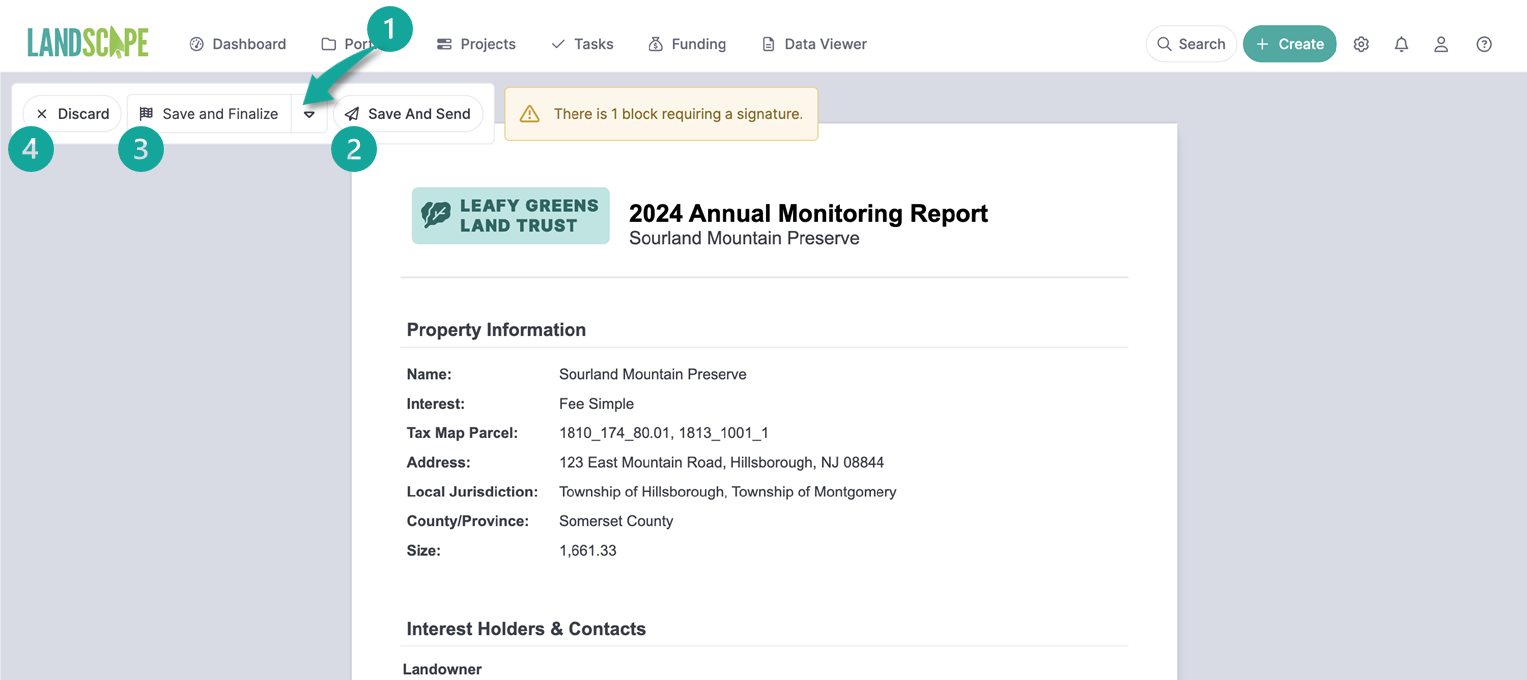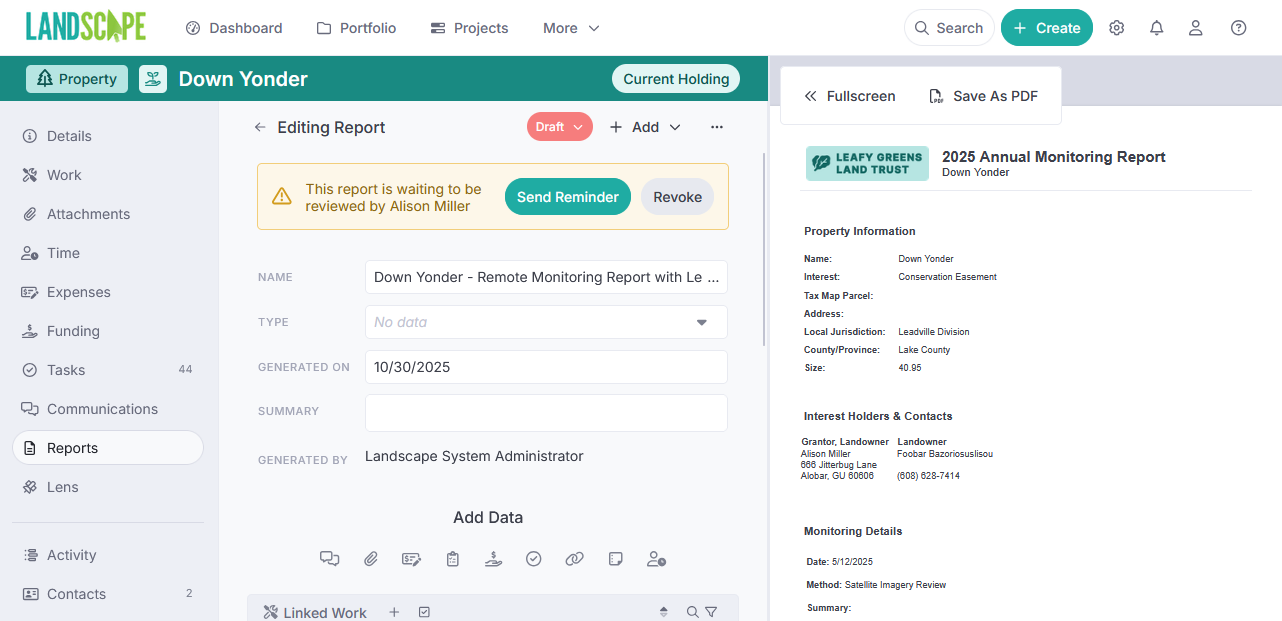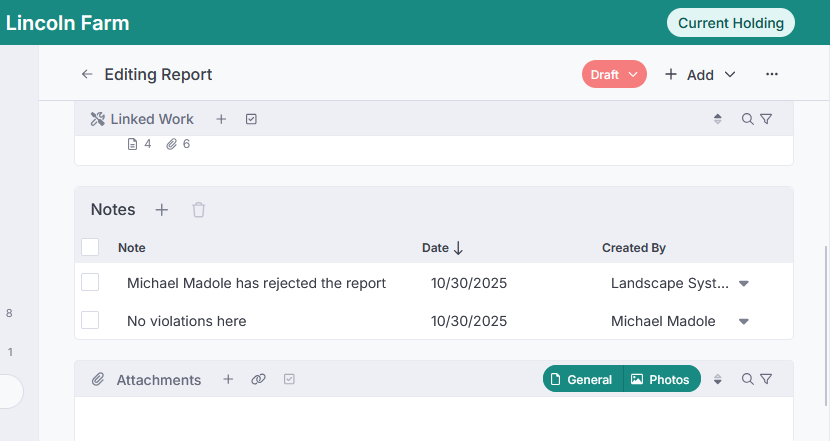Running, saving, and reviewing reports
In this article:
In Landscape, a report is a way of merging data from your account into a customizable .pdf template. You can have as many templates as you would like. Most people first encounter reports when creating their annual monitoring reports, but reports can also be used to create baseline photo sheets and maps, project status reports, issue summaries, and much more. Report templates are edited from within settings.
After a report is run, it can be saved for later review. Saved reports are stored in the 'Reports' tab of a property record. They are also listed in the 'Saved Reports' tab of the Data Viewer.
Running a Report
There are several ways to run a report: From within a work item; from the 'Reports' tab; from the main 'Details' tab of a record or project; and from Data Viewer (for running multiple reports at once).
If you don't see the report template you're looking for in any of the contexts described below, make sure that the report template has the correct category applied to it. For example, to run a report from a site visit work item, a report must have a category of 'Site Visit'.
From a work item
This is the quickest way of running a single report for work.

First, navigate to the appropriate work item from the work tab. For example, if you want to create a monitoring report for a site visit, navigate to that site visit. Then, click 'Run Report' at the top of the record, and select the report you want to run.
From the 'Details' tab
The Portfolio Record or Project 'Details' tab is where you would run a report with a category of 'Portfolio Records' or 'Projects,' respectively. Click 'Run Report' in the top right corner of the page and select the desired template:

If the template you select has a work-item specific category, like 'Issues', you will also be prompted to choose which work item to associate with the report:

From Data Viewer
Use Data Viewer when you need to run the same report for multiple records in bulk. Read more here: Running a report on multiple records at once from Data Viewer.
Saving a report
Once you have completed the 'Run Report' process from any of the contexts above, Landscape will generate a draft of the report and navigate you to a preview screen:

(1) To save the report as a draft and return to it later, click on the arrow next to 'Save and Finalize' and select 'Save as Draft'. This will save the report to the 'Reports' tab of a record. This is a good option if you would like to navigate away from the preview and still need to review the report later. Once a report is saved as a draft, you can find it via the Reports tab in the record and you can save it as a .pdf, send it to another user, delete it, or regenerate it.
(2) To save the report and send it to another user for review, select 'Save and Send'. The report will be saved to the 'Reports' tab of the record, and the user will be notified via notifications and email that they have a report to review. The following section describes the review process in more detail.
(3) To finalize the report, mark it as completed, and save it as a .pdf, click 'Save and Finalize'. The completed report, along with the .pdf, will appear in the Reports tab of the record. The .pdf may take some time to generate, but will appear when it is done. You can then download and print the finalized report .pdf if necessary.
(4) 'Discard' will discard the report draft. You can always regenerate it later.
Reviewing reports
Several things happen after one user sends a report to another user for review (option 2 in the previous section).
The Sender sees a banner at the top of the Report work item indicating that the report is waiting to be reviewed. The Sender has an option to send a reminder or revoke the report.

The Reviewer gets a notification in Landscape that a new report has been assigned to them. They may also get an email alert (based on their personal Settings).

The Sender can view all reports they have generated, and their statuses, from the Reports tab > Saved Reports > Reports You Generated.
The Reviewer can view all reports assigned to them, their statuses, and who generated them from the Reports tab > Saved Reports > Reports to Review.
The Reviewer clicks on an assigned report to review it. They can add notes and edit Form responses, photo captions, and map views directly within the draft report.
The Reviewer can then ACCEPT or REJECT the report. In both scenarios, the Sender is notified via email that the report was either accepted or rejected, and a note documenting the review outcome is automatically added to the Report work item.

The Report then disappears from the Reviewer's list of Reports to Review.
If the report was rejected, the Sender can regenerate the report with updated information — addressing the Reviewer's comments — and send the report for another review.
